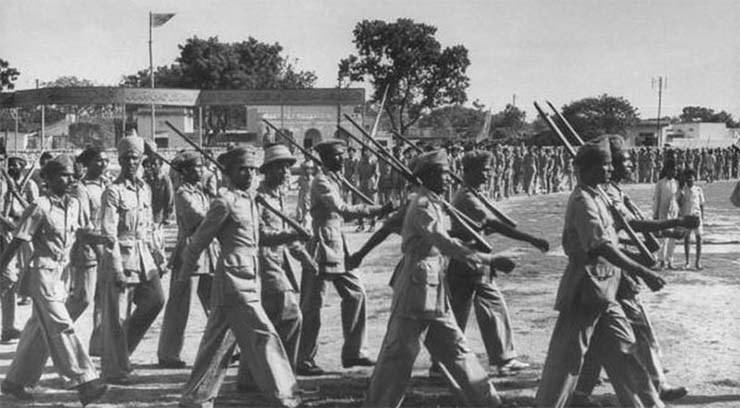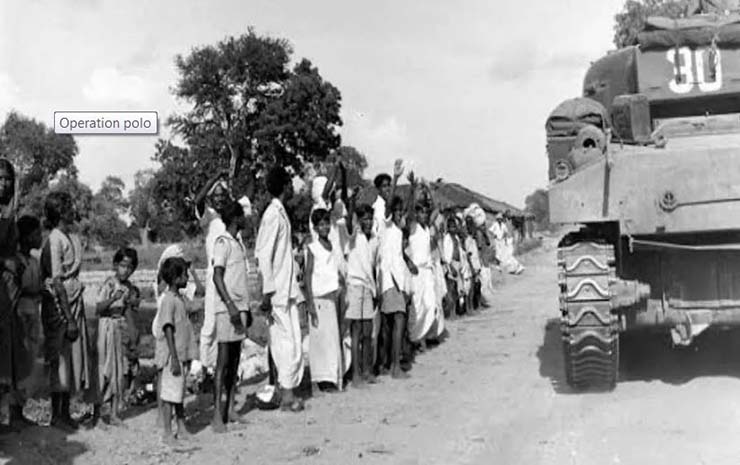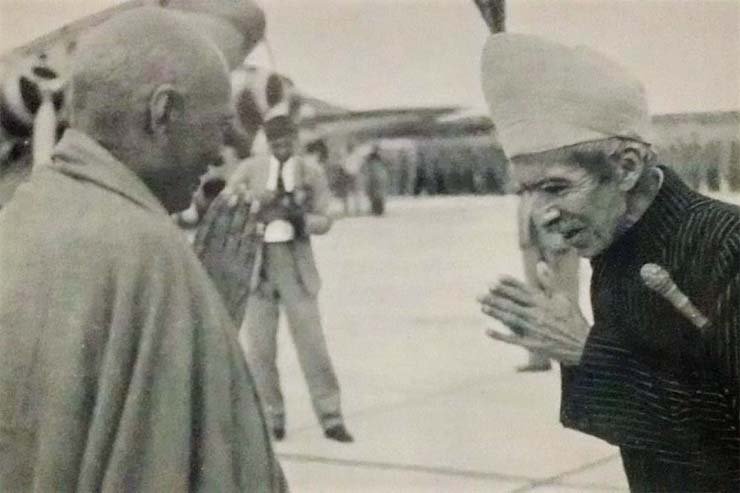
One of the last things that Lord Mountbatten, wanted to do before he finally left India on 23 June 1948 was to solve the Hyderabad issue. Hyderabad was the only state which has not decided to join either India or Pakistan.
Asaf Jah Nawab Mir Osman Ali Khan Bahadur the Nizam of Hyderabad wanted to remain independent. Pronounced the world’s richest man by TIME Magazine in the early 1940s, Osman Ali wanted Hyderabad to stay away from both India and Pakistan and had openly said so, on many occasions. He had the tacit support of Sir Winston Churchill the British Prime Minister.
But what is not so well known, is that the Nizam had donated large sums of money to Great Britain during the First World War to buy aircraft for three Royal Air Force (RAF) squadrons numbered 110, 152, and 253. As a special gesture of thanks, these RAF squadrons were called Hyderabad Squadrons.
Hyderabad was part of Deccan Subha during the Mughal rule. The Subedar or Nizam was the head of the executive and judicial departments and source of all civil and military authority in the Deccan. He drafted his own laws and raised his own armies. All officials were appointed by him or reported directly to him. After the downfall of the Moghul rule, Nizam Mir adopted the title of Nizam-ul-Mulk and laid the foundation of the princely state of Hyderabad. He wanted to be an independent King, but his happiness was short-lived as he was defeated by East India Company forces. Thus Hyderabad the largest state in terms of area, population, and revenue become a part of the British Empire.
During those days 85% of the population of Hyderabad were Hindu. But nearly 70-80% of the posts in police, army, and public administration were occupied by the Muslims. The Muslim officers, not only occupied the highest administrative posts and drew the highest salaries, but also owned almost 40% of the total land in the prosperous state which had its own army, airline, telecommunication system, railway network, postal system, currency, and radio broadcasting service.
Osman Ali the Nizam of Hyderabad was a good friend of Jinnah and had granted Rs 20 crore to Jinnah.
But in spite of his pro-Muslim bias or close relations with Jinnah, the Nizam did not wish to join either India or Pakistan and requested the British to accept Hyderabad as an independent constitutional monarchy within the Commonwealth of Nations after the British withdrew from India. His plea was however rejected by Lord Mountbatten. So the Nizam proceeded to appoint trade representatives in European countries and started negotiations with the Portuguese to lease or buy Goa which would provide access from his state to the sea.
Osman Ali was particularly afraid of Sardar Patel and in the back of his mind knew that sooner or later, he would try to annex Hyderabad. So he requested Mountbatten to appoint a British officer as his legal advisor. Hence Sir Walter Monckton who had worked in the British propaganda and information department during World War II and served as Solicitor General in Winston Churchill’s caretaker government was appointed as Advisor. One of his main roles as a representative of the British Empire was to entangle the Indian Prime Minister in International legalities and thus counter the Iron man of India.
On 15 August 1947, there were 562 princely states and provinces spread over 5 lakh square miles. They were given the option to join India, Pakistan or remain independent. Mahatma Gandhi never wanted partition but partition became inevitable because of ego clashes between Nehru and Jinnah triggered by the British divide and rule policy.
After the partition, Sardar Patel quickly went about amalgamating the princely states. Patel’s tireless efforts paid off as almost all of the princely states except Hyderabad, Junagadh, Goa, and Jammu Kashmir joined the Indian Union by 15 August 1947.

The Nawab of Junagadh Muhammad Mahabat Khanji III decided to accede to Pakistan on September 15, 1947, much to the displeasure of the majority of people in the state who were Hindus. Patel asked Pakistan to reverse its acceptance of the accession but when it refused, India moved in and annexed Junagadh on November 9, forcing the nawab to flee to Karachi with his family. This was followed by a plebiscite, in which 99% of the people of Junagadh decided to be a part of India.
Meanwhile, the Nizam of Hyderabad continued to play hard to get and openly declared his intention to remain independent. He even went to the extent of warning India, of unprecedented bloodshed and communal violence if it tried to forcibly annex Hyderabad.
At his behest, the Razakars a band of about 200,000 irregular militia led by Kasim Razvi started indiscriminately killing Hindus, abducting or raping women, looting trains, shops, and non-Muslim property. As a result, thousands of Hindus started fleeing from the state. To put an end to this anarchy, Sardar Patel invited a delegation from Hyderabad for negotiations. Sir Monchkton, Kasim Razvi and Yawar Jung were part of the delegation. They threatened Patel that the life of 12 million Hindus would be hell if he tried to annex Hyderabad, but were taken aback when Patel asked them to worry about the much larger number of Muslims in other parts of India.
Meanwhile, a standstill memorandum had been signed between India and Hyderabad in Nov 1947 with a condition that Hyderabad would not join Pakistan and the Indian government appointed Kanhiya Lal Munshi to keep a watch on the activities of the Nizam and facilitate negotiations between both parties as an observer.
The Nizam was not happy and shared his frustration with Morchkton who complained to the British government that Mountbatten had failed in his duties to protect Hyderabad and called Munshi, a rogue Indian agent to keep an eye on his activities.
A special delegation was sent to Delhi with a proposal that Hyderabad wished to be neutral and maintain friendly relations with both India and Pakistan. On the orders of Sardar Patel, the Hyderabad delegation was sent back by the same flight.
Meanwhile, an urgent meeting was held in Delhi where Patel briefed Mountbatten, and Nehru about the atrocities committed on the Hindus with the concurrence of the Nizam in Hyderabad and tried to convince them about the need for immediate military action. Mountbatten pointed out that this would be a violation of international protocols while Nehru did not want to be labeled as an invader by the international fraternity. Both of them feared that military action would lead to communal violence all over India. Patel was disappointed as he knew that the situation in Hyderabad would worsen further if no action was taken.
Meanwhile, Munshi regularly kept reporting about extensive violence, looting, and rapes by the Razakars forcing thousands of Hindus to leave Hyderabad. Patel wrote a letter to the Nizam to stop the violence if the Nizam was finding it difficult to control the law and order situation or rope in the Razakars. The Nizam replied that the situation was very much under control but offered to seek the intervention of the President of the United States if Patel was not convinced.
Patel was furious when he read Nizam’s reply. He was not keeping well and had been advised by his physicians to take a rest in a hill station. To add fuel to the fire, the Nizam sent him a message that a delegation led by Laik Ali was going to leave for New York to lodge a complaint at UN headquarters against border violations by the Indian Army. Simultaneously, he requested Lord Mountbatten to make necessary arrangements for the delegation at the Delhi Airport and onwards voyage to America.
Sardar Patel lost his cool and denied the permission. Hence the Hyderabad delegation changed the route and landed in New York via Karachi. Mountbatten wanted to resolve the issue so he worked out a plan keeping Nehru and Monckton in the loop. As per the plan, Hyderabad would retain its independent status, while Delhi would look after its defence, and foreign policy. The plan also provided that the Razakars would be banned, while the strength of the Nizam’s Army would not exceed 20,000 troops. Further, there was a provision for a plebiscite after a new government was formed in Hyderabad. The Nizam wanted a Muslim majority in the cabinet.

Accordingly, a draft agreement was prepared and put up before the core committee after being signed by Nizam. Nehru approved it but wasn’t sure whether Patel would agree so before leaving for London Mountbatten offered to visit Patel in Dehradun where he was undergoing treatment.
After the pleasantries were over, Mountbatten told Patel that he was finally leaving India but had a last request. He read out the Draft Plan. As expected, Patel was furious and flatly refused to sign the agreement. So Mountbatten changed the topic. Later, after the informal farewell dinner, Mountbatten resumed the discussion in a congenial atmosphere and said although they had differences of opinion on a number of issues, he always respected Patel as a good friend. Mountbatten then took out the draft agreement and said he wanted a farewell gift. Patel was taken aback and asked him why it was so important for him. Mountbatten candidly replied that his reputation was at stake and he did not want to leave with an unfinished agenda. So without waiting for another second Patel signed the agreement to Mountbatten’s utmost surprise. Both had tears in their eyes and embraced each other against all protocols.
Before Mountbatten left, Sardar Patel whispered in his ears, “Mark my words, the Nizam will never honor this agreement.”
Patel was right. As soon as Motckton reached Hyderabad with the draft agreement and wanted to meet the Nizam, the terms and conditions especially the ones banning the Razakars were leaked and rejected by Laik Ali and Kasim. This led to a revolt and the Nizam was held captive in his palace. Meanwhile, there was chaos in Hyderabad and the Razakars continued to kill innocent people in the state. Motckton reported the situation to Delhi.
Mountbatten left for London with a heavy heart and C. Rajagopalachari took over as the first Indian Governor General.
As soon as Sardar Patel recovered and resumed duties, he asked for a first-hand report on the ground situation and decided to give the go-ahead for military action. So as the Acting Prime Minister when Nehru was touring Europe, he briefed the GOC-in-C Southern Command Gen Maharaj Rajendrasinhji Jadeja who came up with the strategic plan for the liberation of Hyderabad. The tentative date of the top secret plan called Operation Polo was fixed as 13 Sep 1948. Jawaharlal Nehru was extremely upset when he came to hear of this. Nehru was still not in favor of military action when Sardar Patel disclosed the plan in front of the cabinet committee on security. But when Patel explained how lakhs of Hindus were being tortured and killed by Razakars, he agreed but asked Patel to seek the advice of Gen Roy Butcher the Commander In Chief of the Indian Army.
Patel knew that Gen Butcher would not agree. This is exactly what happened as Gen Roy Butcher argued that War would cause destruction of life and property. Patel countered this by asking him – why did you fight the World Wars when you knew so many people will be killed? Butcher obviously had no answer and agreed but on the condition that no British officer or troops would participate in the operation. Sardar Patel told him not to worry and said the Indian troops were quite capable of carrying out the operation.
Accordingly, the Indian troops started assembling in the concentration areas on 12 Sep 1948. But as luck would have it, Jinnah died the same day. Gen Butcher called up Nehru and asked him to call off the operation as the whole Muslim world would go against India. He quoted intelligence reports that hundreds of Bombers from Saudi Arabia would bomb Bombay, Calcutta, and Delhi. Nehru told this to Patel who advised him to meditate and sleep.
Finally, Operation Polo was launched as scheduled at the first light on 13 September 1948 with Lt. Gen. Rajendrasinhji as the overall commander. The plan envisaged two main thrusts – from Vijayawada in the East led by Maj Gen Ajit Rudra and Solapur in the West led by Maj Gen J. N. Choudhary. The operation lasted 5 days.
By the morning of the 5th day, the Hyderabad army and Razakars had been routed with extremely heavy casualties on all fronts. The Indian Army suffered 9 casualties whereas 2100 personnel of the Nizam state forces and Razakars were killed, 5000 were wounded and 5000 were captured in the operation.
Faced with a looming defeat, the Nizam summoned his Prime Minister, Mir Laiq Ali, on 16 September, and asked him to resign along with the entire cabinet by the next day.

Finally, at 5 pm on 17 September, the Nizam announced a ceasefire ending 13 months of political uncertainty in the state, and the Commander of the Hyderabad State Forces Maj Gen Syed Ahmed El Edroos surrendered before Maj. Gen. J. N. Chaudhuri, who later went on to be the 5th Chief of Army Staff of the Indian Army.
On 18 Sep 1948 in a fiery speech in parliament Sardar Patel, informed the Nizam had been defeated. Nehru however was more diplomatic in his speech and said that India should pay respect to the erstwhile Nizam Osman Ali Khan who was made Governor of Hyderabad from January 26, 1950, to October 31, 1956. Sardar Patel was not happy with the policy of appeasement but remained silent.
The next day at the cabinet meeting N. Gopalaswami Ayyangar who had been a Minister without portfolio in the first Nehru cabinet recommended a meeting of foreign diplomats to justify the Hyderabad Operation. Sardar Patel rejected the proposal saying that there was no need to feel guilty as it was an internal matter of India. Unlike Nehru, Patel was not overtly bothered about international opinion.
Curiously, Ayyangar succeeded Sardar Patel, after his death on December 15, 1950, and went on to be the Defence Minister of India.
If Hyderabad is today an integral part of India, it is because of the valor of the Indian Army and Sardar Patel, who completed the unification of India in spite of heavy odds. The Statue of Unity, the tallest in the World, is the heartiest tribute to the Iron man of India.
-The writer is an Indian Army veteran and a defence analyst. He has keen interest in Geo-strategic affairs and writes regularly on internal and external affairs issues related to India and neighbours. The views expressed are personal and do not necessarily reflect the views of Raksha Anirveda.








